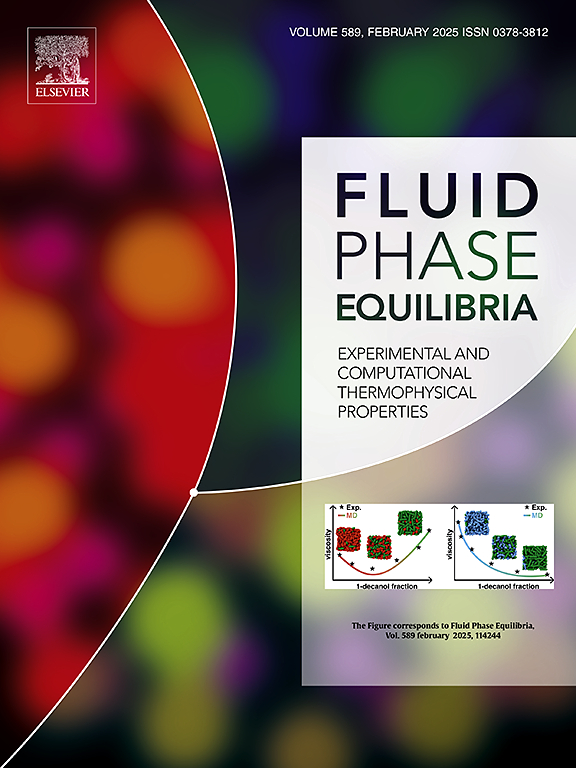Effects of temperature and flue gas composition on miscibility behavior between flue gas and gas condensate
IF 2.7
3区 工程技术
Q3 CHEMISTRY, PHYSICAL
引用次数: 0
Abstract
Thermal miscible flooding has shown promise in enhancing light oil recovery from gas condensate reservoirs. In this process, the generated flue gases could become miscible with gas condensate under elevated reservoir temperatures. To study the miscibility behavior between flue gas and gas condensate, we develop a thermodynamic model based on the Peng-Robinson equation of state (PR EOS) coupled with Peneloux volume translation, for a benchmark gas condensate sample. The pseudocomponents’ properties are tuned to match the constant composition expansion (CCE) and the constant volume depletion (CVD) test data. The tuned model can well reproduce measured data (e.g., relative volume and liquid dropout) in these tests. We then apply it to calculate the phase envelopes of N2-gas condensate, CO2-gas condensate, and CO2![]() N2-gas condensate mixtures, revealing the shifts in original phase envelopes. Next, to investigate the influences of temperature and flue gas composition on miscibility behavior, we utilize the analytical tie line method and the cell-to-cell method to calculate the MMPs and drive types of different flue gas-gas condensate mixtures. It is found that the MMP of a given injection gas first increases with temperature, reaches a peak, and then decreases. The dimensionless fraction of vaporizing mechanism of a given injection gas decreases with temperature. The highest MMPs of CO2 and N2 are 506 bara at 350 °C and 620 bara at 250 °C, respectively. If the flue gas contains more N2, the peak MMP and the dimensionless fraction of vaporizing mechanism increase, but the temperature corresponding to the peak MMP is reduced.
N2-gas condensate mixtures, revealing the shifts in original phase envelopes. Next, to investigate the influences of temperature and flue gas composition on miscibility behavior, we utilize the analytical tie line method and the cell-to-cell method to calculate the MMPs and drive types of different flue gas-gas condensate mixtures. It is found that the MMP of a given injection gas first increases with temperature, reaches a peak, and then decreases. The dimensionless fraction of vaporizing mechanism of a given injection gas decreases with temperature. The highest MMPs of CO2 and N2 are 506 bara at 350 °C and 620 bara at 250 °C, respectively. If the flue gas contains more N2, the peak MMP and the dimensionless fraction of vaporizing mechanism increase, but the temperature corresponding to the peak MMP is reduced.
温度和烟气成分对烟气与凝析气混相行为的影响
热混相驱在提高凝析气藏轻质油采收率方面表现出了良好的前景。在此过程中,在升高的储层温度下,产生的烟气可能与凝析气混相。为了研究烟气与凝析气之间的混相行为,我们建立了一个基于Peng-Robinson状态方程(PR - EOS)和Peneloux体积平移的热力学模型,用于基准凝析气样品。调整了伪元件的性能以匹配恒定成分膨胀(CCE)和恒定体积损耗(CVD)测试数据。调整后的模型可以很好地再现这些测试中的测量数据(例如,相对体积和液差)。然后,我们将其应用于计算n2 -凝析气、co2 -凝析气和co2n2 -凝析气混合物的相包络,揭示了原始相包络的变化。接下来,为了研究温度和烟气成分对混相行为的影响,我们利用分析系线法和细胞-细胞法计算了不同烟气-凝析气混合物的MMPs和驱动类型。研究发现,给定注入气体的MMP随温度的升高先升高,达到峰值后减小。给定喷射气体的汽化机理无因次分数随温度的升高而降低。在350℃时CO2和N2的最大MMPs分别为506 bara和620 bara。当烟气中N2含量增加时,MMP峰值和汽化机制的无因次分数增加,但MMP峰值对应的温度降低。
本文章由计算机程序翻译,如有差异,请以英文原文为准。
求助全文
约1分钟内获得全文
求助全文
来源期刊

Fluid Phase Equilibria
工程技术-工程:化工
CiteScore
5.30
自引率
15.40%
发文量
223
审稿时长
53 days
期刊介绍:
Fluid Phase Equilibria publishes high-quality papers dealing with experimental, theoretical, and applied research related to equilibrium and transport properties of fluids, solids, and interfaces. Subjects of interest include physical/phase and chemical equilibria; equilibrium and nonequilibrium thermophysical properties; fundamental thermodynamic relations; and stability. The systems central to the journal include pure substances and mixtures of organic and inorganic materials, including polymers, biochemicals, and surfactants with sufficient characterization of composition and purity for the results to be reproduced. Alloys are of interest only when thermodynamic studies are included, purely material studies will not be considered. In all cases, authors are expected to provide physical or chemical interpretations of the results.
Experimental research can include measurements under all conditions of temperature, pressure, and composition, including critical and supercritical. Measurements are to be associated with systems and conditions of fundamental or applied interest, and may not be only a collection of routine data, such as physical property or solubility measurements at limited pressures and temperatures close to ambient, or surfactant studies focussed strictly on micellisation or micelle structure. Papers reporting common data must be accompanied by new physical insights and/or contemporary or new theory or techniques.
 求助内容:
求助内容: 应助结果提醒方式:
应助结果提醒方式:


